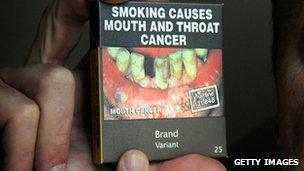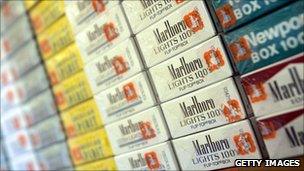Australia smokers given plain packs
- Published
- comments

Grim health warnings like this are replacing the branding on cigarette packets in Australia
Australia has become the first country in the world to introduce plain packaging for cigarettes.
From now, all tobacco company logos and colours will be banned from packets.
They have been replaced by a dreary, uniform, green/brown, colour accompanied by a raft of anti-smoking messages and photographs.
The only concession to the tobacco companies is their name and the name of the brand variant in small print at the bottom of the box.
"This is the last gasp of a dying industry," declared Australia's Health Minister Tanya Plibersek.
Anne Jones of the anti-smoking group Ash (Action on Smoking and Health) agrees.
"Plain packaging has taken the personality away from the pack", she says.
"Once you take away all the colour coding and imagery and everything is standardised with massive health warnings, you really do de-glamorise the product."
Cigarette packets were practically the last platform for tobacco companies to advertise themselves.
Commercials on Australian television and radio were banned in 1976. Newspapers followed in 1989.
Targets set
Tobacco sponsorship of sport and cultural events was prohibited in 1992.
That left the packets themselves, which became a target for the current Labor government.
The government's efforts were led by then-Health Minister Nicola Roxon whose own father, Jack, died from a smoking-related illness when she was 10.
The government argued that with 15,000 smokers dying each year at a cost to society of AU$30bn (£19bn) it had a duty to act.
It set the target of reducing smoking levels from 16% of the population in 2007, to less than 10% by 2018.
In May 2011, Cancer Council Australia released a review of the evidence surrounding the introduction of plain packaging. The review suggested that packaging plays an important part in encouraging young people to try cigarettes.
That was followed by a telling video, released by anti-smoking campaigners, showing children discussing existing cigarette packets.
One boy says the red on one packet reminds him of his favourite car, a girl admires the pink on another packet, while another boy talks about the "heavenly" colours on his box.
The combined messages about the efficacy of logos and colours in selling cigarettes, helped prompt the government to begin its legislative push to introduce plain packaging.
Not surprisingly, the tobacco industry resisted.
A consortium of major companies, including Phillip Morris, Imperial Tobacco and British American Tobacco (BAT) came together to plan a counter punch.
That included an extensive media campaign to try to persuade the public and government of the shortcomings of plain packaging.

Tobacco companies say removing the branding from cigarettes will not stop people smoking
BAT's spokesman, Scott McIntyre, says: "Plain packaging has always been misleading and won't stop smoking because branded cigarettes will be smuggled in and because tobacco companies will have to respond to that by cutting prices to stay competitive."
Despite those arguments, last August Australia's High Court ruled in favour of the government.
It threw out technical arguments by the tobacco companies that the government was trying to "acquire" their intellectual property rights by removing logos.
"Plain packaging is a game changer," says Anne Jones, a veteran of anti-smoking campaigns.
"It means that you can take on big tobacco and win."
It's known that Britain, France, Norway, India and New Zealand have been among those following the Australian court case closely, to see if there are any lessons for similar plain packaging measures in their countries.
Rare legal set back
But Scott McIntyre of BAT says it is not that straightforward, arguing that the Australian government only won because of the peculiarities of Australian constitutional law.
But there is no doubt that tobacco companies have suffered a rare legal set back, although there could still be further action by them at the World Trade Organization.
"We don't fear that," says Anne Jones of Ash.
"Plain packaging is here to stay in Australia. We now plan to go after the ingredients contained in cigarettes."
Anti-smoking lobbyists like Anne Jones know that packaging changes alone wont significantly curb smoking, especially among established smokers.
Price, availability, information campaigns and health messages play an equally important role.
But cigarette packets will no longer be mini, mobile advertising boards and, for those working to reduce smoking levels, plain packaging is an important stage in the shift to a smoking-free society.
- Published15 August 2012
- Published15 August 2012
- Published15 August 2012
- Published10 August 2012
- Published10 November 2011